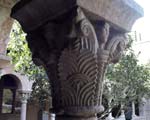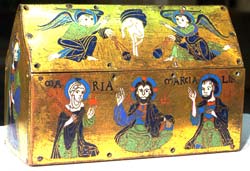 |
 |
 |
| Lecture 9. Romanesque |
|
This leads to the idea of "style." A "stylus" is a delicate writing instrument; "style" is a classifying concept to allow us to relate multiple objects to each other through a system of similarity and difference and to make sense of them. Terms like "Early Christian," "Byzantine," "Migration Art," or "Carolingian Art" are based upon historical designations. "Romanesque" and "Gothic" are "style" terms. They are inherently unstable since they attempt to combine two things -- first an overall degree of sameness that links objects and second, a set of conclusions about context. We are left forever wondering whether "Romanesque" is principally a style or a period. The origins of the concept of "Romanesque" lie in dependence on Roman work. Gothic was seen as the logical conclusion --Romanesque was merely a prelude. We may also consider the sameness of the Pilgrimage Churches to be understood through a cumulative experience. The patterned journeys of pilgrimage -- varied geography studded with churches that looked the same. II. Limoges enamels. Read the famous passage from Abbot Suger on the role of the glistening object. Limoges -- a Roman city called Augustoritum Lemovicensium. The focus of the medieval town was around the episcopal center, the castle of the viscount of Limoges and the monastery of Saint Martial (first bishop of Limoges) located inside the walled city attached to the castle. As part of the Duchy of Aquitaine with the counts of Poitiers/Dukes of Aquitaine as suzerain. there was also a mid 12th-century lineage linked with Plantagenets. Enamelwork in Limoges grew out of the regional demand created by Saint Martial. The high quality of the objects led to the growth of a supra-regional demand. Copper was the basic raw material. The key to the technique -- the binding of enamel onto copper. The first use of term "opere Limovicense" occurs in a letter of 1167-1169. The techique is first mentioned in the mid-3rd C BC by Philostratus, "It is said that the barbarians of the Atlantic Ocean pour these colors into bronze moulds and that the colors become as hard as stone, preserving the designs." The La Guierche Vase. Limoges was situated on the intersection of major trade routes from Roman times. Pilgrimage routes to Spain; strong links with England with patronage of Plantagenets. Strong local tradition of gold work--Saint Eligius (588-660) the patron of goldsmiths was born near Limoges. Industry resulted from the needs of a vast and wealthy clientele.
|



